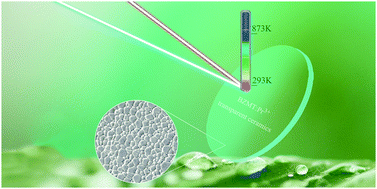A wide temperature range dual-mode luminescence thermometer based on Pr3+-doped Ba(Zr0.16Mg0.28Ta0.56)O3 transparent ceramic†
Abstract
Owing to the impact of robust thermal quenching, lanthanide-based luminescence thermometer operation can usually only be achieved within a comparatively small temperature scope (ambient temperature to 800 K). Here, this study presents a method for addressing the mentioned limits, and a luminescence thermometer with an ultra-wide temperature range has been achieved, which adopted Pr3+-doped Ba(Zr0.16Mg0.28Ta0.56)O3 transparent ceramic to be the optical temperature probe. Based on the high luminescence intensity and excellent thermal stability of the 3P0–3F2 hypersensitive transition of Pr3+ in Ba(Zr0.16Mg0.28Ta0.56)O3 transparent ceramic, the intensity ratio of the emissions at 624 nm and 649 nm was employed for temperature sensing in an ultra-wide range (293–873 K), and the maximal relative sensitivity reached 1.05% K−1, outperforming most existing luminescence temperature measurement transparent ceramics. Furthermore, in Pr3+-doped Ba(Zr0.16Mg0.28Ta0.56)O3 transparent ceramic, the lifetime of the 3P0–3H4 transition also exhibits prominent optical thermometry performance (303–873 K). The results presented in this work may be of high significance for the design of novel ratiometric/lifetime dual-mode optical temperature sensors in the high-temperature measurement field.



 Please wait while we load your content...
Please wait while we load your content...